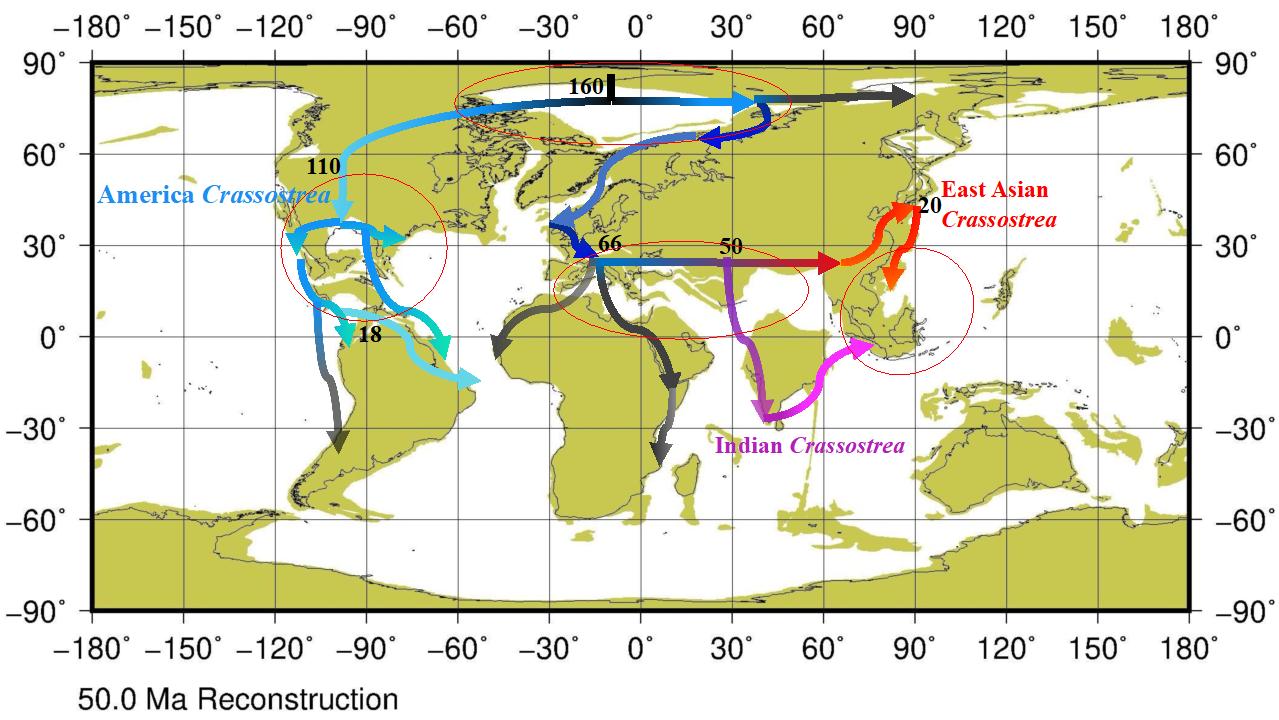Oysters possess great potentials in biogeographical and palaeogeographical studies because of the long evolutionary history, worldwide distribution, and well representation in the fossil record.
The researchers from the Institute of Oceanology, Chinese Academy of Sciences, collected a large number of oyster samples from the coast of China. Using combined mitochondrial and nuclear gene makers, they reconstructed the global phylogenetic and biogeographical relationships throughout the evolutionary history of oysters.
The study was published in Molecular Phylogenetics and Evolution. (https://www.sciencedirect.com/science/article/abs/pii/S1055790321002013?via%3Dihub)
The phylogenetic results and fossil evidence indicated that Ostreidae originated from the circum-Arctic region in the Early Jurassic. After that, there were four geological-scale shifts of biodiversity hotspots and species replacement.
During the late Jurassic to early Cretaceous (~180-100 million years ago), the circum-Arctic realm was an important area for the origin, preservation, and migration of oysters. The connectivity and isolation of continents surrounding the Arctic region, and the expansion of the North Atlantic might promote the formation of ancestral species of oyster subfamilies.
In the late Cretaceous (~100-66 million years ago), the east and west coasts of the North Atlantic existed a high diversity of oysters.
During the Tertiary period (~66-23 million years ago), the diversity hotspot of oysters shifted from northeastern America to Central America and spread from the Tethys to the Indian Ocean and East Asia. The shrinkage of the Tethys promoted the differentiation of the major genus of oysters. Especially, for the genus Crassostrea, its differentiation coincided with the occurrence of geological events.
Since the collision between India and Eurasia (~45 million years ago), especially since Miocene (~ 23 million years ago), the tropical western Pacific gradually evolved into one of the biodiversity hotspots of oysters, which played an important role in the preservation of extant oyster species.
It was also found that there are other characteristics not the dispersal ability of oyster larvae that played a more important role in the formation of oyster distribution patterns. The diversity dynamics inferred by standard phylogenetic are consistent with the fossil record, however, further systematic classification, especially for fossil genus Ostrea, would enhance our understanding on extant and fossil oysters.
The studies were supported by the National Science Foundation of China, Strategic Priority Research Program of CAS, National Key R&D Program of China, the Biological Resources Programme, CAS, the earmarked fund for Modern Agro-industry Technology Research System.

Possible main migratory routes of Crassostrea. Circles indicate the highest diversity region of Crassostrea in history and modern time. The unit of time is million years ago (Ma).
Cui Li, Qi Kou, Zhen Zhang, Lisha Hu, Wen Huang, Zongmei Cui, Yumeng Liu, Peizhen Ma, Haiyan Wang. Reconstruction of the evolutionary biogeography reveal the origins and diversification of oysters (Bivalvia: Ostreidae). Molecular Phylogenetics and Evolution, 2021, 164. https://www.sciencedirect.com/science/article/abs/pii/S1055790321002013?via%3Dihub
(Editor: ZHANG Yiyi)
|
|

Address: 7 Nanhai Road, Qingdao, Shandong 266071, China
Tel: 86-532-82898902 Fax: 86-532-82898612 E-mail: iocas@qdio.ac.cn


